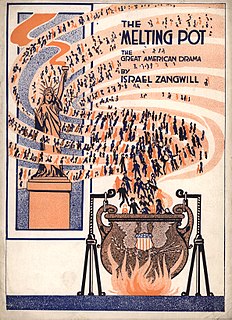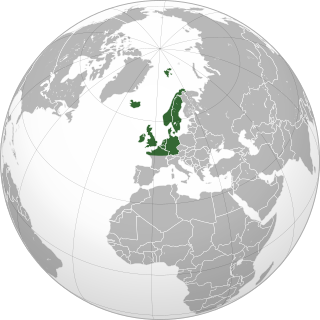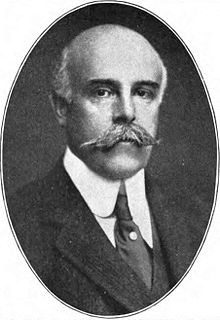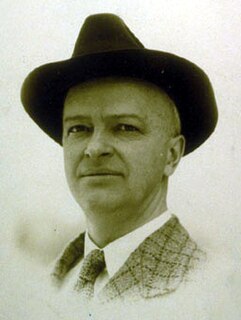Related Research Articles
Eugenics is a set of beliefs and practices that aim to improve the genetic quality of a human population, historically by excluding people and groups judged to be inferior or promoting those judged to be superior.
White is a racial classification and skin color specifier, generally used for people of European origin; although the definition can vary depending on context, nationality, and point of view. This term has at times been expanded to encompass persons of South Asian, West Asian, and North African descent, persons who are often considered "non-white" in other contexts in the United States. It has also controversially been alleged that, in the United States, people of Southern European and even Irish descent have been excluded from this category, although this idea has been contested. The usage of "white people" or a "white race" for a large group of mainly or exclusively European populations, defined by their light skin, among other physical characteristics, and contrasting with "black", "red", "brown", "yellow", and other "colored" people or "persons of color", originated in the 17th century. Prior to this, Europeans also described people from East Asia as being "white". It was only during the 19th century that this vague category was transformed in a pseudo-scientific system of race and skin color relations.

The melting pot is a monocultural metaphor for a heterogeneous society becoming more homogeneous, the different elements "melting together" with a common culture; an alternative being a homogeneous society becoming more heterogeneous through the influx of foreign elements with different cultural backgrounds, possessing the potential to create disharmony within the previous culture. Historically, it is often used to describe the cultural integration of immigrants to the United States.

The Immigration and Nationality Act of 1965, also known as the Hart–Celler Act, is a federal law passed by the 89th United States Congress and signed into law by President Lyndon B. Johnson. The law abolished the National Origins Formula, which had been the basis of U.S. immigration policy since the 1920s. The act removed de facto discrimination against Southern and Eastern Europeans, Asians, as well as other non-Northwestern European ethnic groups from American immigration policy.

Northwestern Europe, or Northwest Europe, is a loosely defined subregion of Europe, overlapping Northern and Western Europe. The region can be defined both geographically and ethnographically.
Scientific racism, sometimes termed biological racism, is the pseudoscientific belief that empirical evidence exists to support or justify racism, racial inferiority, or racial superiority. Historically, scientific racism received credence throughout the scientific community, but it is no longer considered scientific. Dividing humankind into biologically distinct groups is sometimes called racialism, race realism, or race science by its proponents. Modern scientific consensus rejects this view as being irreconcilable with modern genetic research.

European Americans are Americans of European ancestry. This term includes people who are descended from the first European settlers in America as well as people who are descended from more recent European arrivals. European Americans are the largest panethnic group in the United States, both historically and at present.

Madison Grant was an American lawyer, writer, and zoologist known primarily for his work as a eugenicist and conservationist, an advocate of scientific racism and as one of the leading thinkers and activists of the Progressive Era.

The Immigration Act of 1924, or Johnson–Reed Act, including the Asian Exclusion Act and National Origins Act, was a United States federal law that prevented immigration from Asia, set quotas on the number of immigrants from the Eastern Hemisphere, and provided funding and an enforcement mechanism to carry out the longstanding ban on other immigrants.

Harry Hamilton Laughlin was an American educator, eugenicist, and sociologist. He served as the Superintendent of the Eugenics Record Office from its inception in 1910 to its closing in 1939, and was among the most active individuals in influencing American eugenics policy, especially compulsory sterilization legislation.
Race and ethnicity in the United States is a complex topic because the United States of America has a racially and ethnically diverse population. At the federal level, race and ethnicity have been categorized separately.

The Passing of the Great Race: Or, The Racial Basis of European History is a 1916 book by American lawyer, self-styled anthropologist, and fan of the psuedo-science of eugenics, Madison Grant (1865-1937). His fantastical theories espouse the idea that the "Nordic race" is inherently superior to other human beings. This theory and this book were praised by Nazis and were well-received by Adolf Hitler, and used as theoretical justification for the Nazi regime of genocide and mass murder. Grant expounds a theory of Nordic superiority and justifies a caste system based on oppression of some human beings because of transient, superficial, and artificial perceptions of difference.
Panethnicity is a political neologism used to group various ethnic groups together based on their related cultural origins; geographic, linguistic, religious, or 'racial' similarities are often used alone or in combination to draw panethnic boundaries. The term panethnic was used extensively during mid-twentieth century anti-colonial/national liberation movements. In the United States, Yen Espiritu popularized the term and coined the nominal term panethnicity in reference to Asian Americans, a racial category composed of disparate peoples having in common only their origin in the continent of Asia.
American ancestry refers to people in the United States who self-identify their ancestral origin or descent as "American", rather than the more common officially recognized racial and ethnic groups that make up the bulk of the American people. The majority of these respondents are visibly White Americans, who either simply use this response as a political statement or are far removed from and no longer self-identify with their original ethnic ancestral origins. The latter response is attributed to a multitude of generational distance from ancestral lineages, and these tend be of English, Scotch-Irish, or other British ancestries, as demographers have observed that those ancestries tend to be seriously undercounted in U.S. Census Bureau American Community Survey ancestry self-reporting estimates. Although U.S. Census data indicates "American ancestry" is commonly self-reported in the Deep South and Upland South, the vast majority of Americans and expatriates do not equate their nationality with ancestry, race or ethnicity, but with citizenship and allegiance.

Eugenics, the set of beliefs and practices which aims at improving the genetic quality of the human population, played a significant role in the history and culture of the United States during the Progressive Era, from the late 19th century until US involvement in World War II.

The History of White People is a 2010 book by Nell Irvin Painter, in which the author explores the idea of whiteness throughout history, beginning with ancient Greece and continuing through the beginning of scientific racism in early modern Europe to 19th- through 21st-century America.
Southern European people are a pan-ethnic group, or multi-ethnic regional grouping, and the inhabitants of Southern Europe. Mediterranean or Southern Europeans can usually trace back full or partial heritage to Portugal, Italy, Greece, Spain, as well as nations bordering with, or ethnoculturally related to, the region.
Northwestern European Canadians are Canadians of Northwestern European ancestry. Northwestern European Canadian people can usually trace back full or partial heritage to Great Britain, Ireland, Scandinavia, the Netherlands, Northern Germany, Belgium, Northern France, and other nations related with the region geographically or culturally.
Northwestern European Australians are Australians of Northwestern European (Celto-Germanic) ancestry. Northwestern European Australian people may trace full or partial heritage to Great Britain, Ireland, Germany, the Netherlands, Austria, Belgium, German-speaking Switzerland, Scandinavia, the northern regions of France and/or other nations or territories within Northwestern Europe or culturally related.
Northwestern European people are a pan-ethnic group, or multi-ethnic regional grouping, and the inhabitants of Northwestern Europe. Northwest or Northwestern Europeans can usually trace back full or partial heritage to Great Britain and Ireland, Northern Germany, Denmark, Sweden, Norway, the Netherlands, Northern France, Belgium, and other places connected to Northwestern Europe geographically or culturally.
References
- ↑ Aviva Ben-Ur. "Ethnicity and Immigration". Department of Sociology: Princeton University.
Week 4: Northwest European Americans 6. Schneiderman, Howard G. "The Protestant Establishment: Its History Its Legacy-Its Future?" Ch. 10 in (PR).
- ↑ "Boise State University ScholarWorks - Student Newspapers (UP 4.15) - University Documents - Arbiter, January 18". Boise State University. January 18, 1995.
Perhaps Mr. Zangwill saw races and ethnic heritage as negative elements much in need of a good melting. But did he feel that the white, Anglo culture should be melted as well? Logic would seem to dictate that Northwest European-Americans would go into the pot along with everyone else.
- ↑ Paul R. Spickard; Rowena Fong (1995). "Pacific Islander Americans and Multiethnicity: A Vision of America's Future?". Social Forces (Volume 73 ed.). Oxford University Press. p. 1365-1383.
In the assimilationist view, nearly every person who comes to America (as well as those native peoples who preceded northwest European Americans on the continent) at first possesses an identity different from what the assimilationists regard as the American norm.
- ↑ P Bernardini; N Fiering (2001). "The Jewish Moment". The Jews and the Expansion of Europe to the West, 1450-1800. Berghahn Books. p. 503. ISBN 978-1571814302.
In the New World, however, the Northwest Europeans were able to duplicate the Iberian policy of founding settlement colonies. As in Spanish America, the settlers in British, French, and Dutch North America were mainly interested in subsistence farming and interregional trade ... In addition to trade and settlement, the Northwest Europeans also developed a plantation zone, situated in the southeast of North America
- ↑ "The Question of Race in ancient Egypt". University College London. 2003.
- ↑ Thomas Borstelmann (2016). "Inside Every Foreigner: How Americans Understand Others". Diplomatic History (Volume 40 ed.). Oxford University Press. p. 1–18.
Benjamin Franklin’s warning that colonial Pennsylvania was becoming “a Colony of Aliens, who will shortly be so numerous as to Germanize us instead of our Anglifying them and will never adopt our Language or Customs any more than they can acquire our Complexion.” But just as the idea of Germans having a different complexion than other northwestern European Americans came to seem peculiar, so, too, did mainstream public attitudes about race and discrimination
- ↑ Jesse O. McKee (2000). "Humanity On The Move". Ethnicity in Contemporary America: A Geographical Appraisal. Rowman & Littlefield Publishers. p. 20. ISBN 978-0742500341.
Table 1.1 Immigration Periods ... 1821-1880 Northwest European Wave. Heavily Irish, German, British, French, and other northwest Europeans, together with a complement from Canada, China and the West Indies.
- ↑ Vincent N. Parrillo (2012). Diversity in America. Routledge. ISBN 978-1612052540.
- ↑ Paul Spickard (2007). "The Great Wave, 1870-1930". Almost All Aliens: Immigration, Race, and Colonialism in American History and Identity: Race, Colonialism, and Immigration in American History and Identity. Routledge. p. 176. ISBN 978-0415935937.
Although many histories of immigration describe this period from the 1870s to the 1920s as one when the sources of migrants shifted from Northwest Europe to Southern and Eastern Europe - “Old Immigration” versus the “New Immigration,” Northwest Europeans continued to come and stay in very large numbers.
- ↑ Benjamin Bailey (2002). "Introduction". Language, Race, and Negotiation of Identity: A Study of Dominican Americans. University of Massachusetts Amherst. p. 15.
During the heightened immigration associated with the 1880-1920 period, many doubted that the largely Southern and Eastern European newcomers would ever assimilate to the culture of the dominant groups, who were of predominantly Northwestern European origin ... Social differences between these immigrants and European Americans who were already in America were perceived as insurmountable.
- ↑ Russell A. Kazal (2004). "Fate of German America". Becoming Old Stock: The Paradox of German-American Identity. Princeton University Press. p. 279. ISBN 978-0691050157.
Nativists largely of colonial background popularized the idea of a deep divide between northwest-European "Americans" and southeast European immigrants before the First World War.
- 1 2 "Introduction" (PDF), Introduction - Princeton University, Princeton University Press, p. 6-9,
1914 ... Now, within Anglo-America and under the impress of an increasingly racialized nativism, there arose terms denoting a common northwest European consciousness, such as “American race stock”and “old stock.” ... Groups such as the Americanization Committee of Germantown drew on the language of racialized nativism to cast their members—including those of German background—as northwest Europeans who shared the common racial “stock” of “our forefathers.” ... During the 1940s ... Chicago’s working-class and Catholic Germans thereby helped to create a common ground that necessarily influenced the identities of their Irish and new immigrant collaborators. Similarly, when middle-class Germans took refuge in a racial nationalism, they cooperated with other northwest Europeans and echoed the behavior of such other “Nordic” groups as Norwegian Americans.
- ↑ Stanley Lieberson (1981). "Structural Background". A Piece of the Pie: Blacks and White Immigrants Since 1880. University of California Press. p. 26. ISBN 978-0520043626.
But when comparisons are made between immigrants with comparable periods of residence in the United States, there is some reason to believe that the Northwestern Europeans were slower than the new groups to become United States citizens (Gavit, 1922, chapter 8; Liberson 1963a, pp. 141-146).
- ↑ Thomas Powell (1993). "Scholarly & Christian Racism". The Persistence of Racism in America. Rowman & Littlefield Publishers. p. 113. ISBN 978-0822630227.
Why did Americans assume that behavior expresses race traits? ... the public embraced the works of historians like Bancroft, Parkman, and Presscot, who accepted prevailing ideas of inherent inclinations ... the idea of a genetic trait, a germ, genius, or creative spark found in northwest Europeans, which led to high civilization.
- ↑ Beret E. Strong (2008). Seeking The Light: The Lives of Phillips and Ruth Lee Thygeson, Pioneers in the Prevention of Blindness. McFarland & Company. ISBN 978-0786436736.
Unfortunately, in the American version of the eugenics argument, articulated by Madison Grant in his 1916 book, The Passing of the Great Race , the gene pool of descendants of northwestern Europeans was considered strong and worthy, while the southern and eastern Europeans were considered a threat to the gene pool and a source of overpopulation.
- ↑ Susan R. Burgess; Kathryn C. Leeman (2016). CQ Press Guide to Radical Politics in the United States. CQ Press. ISBN 978-1452292274.
At the same time, eugenics was gaining populariy, and scholars such as Lothrop Stoddard and Madison Grant were publishing books on the superiority of northwestern Europeans and the potential problems caused by the increased immigration of other groups to the United States
- ↑ Elspeth Reeve (October 9, 2016). "Alt-right trolls are getting 23andme genetic tests to 'prove' their whiteness". Vice Media.
In the 19th and early 20th centuries, American eugenicists worried that immigrants of “inferior stock” from Southern and Eastern Europe would dilute the old stock of Northwestern Europeans, and argued for sterilization.
- ↑ David Hollinger (May 24, 2019). "When the government used bad science to restrict immigration". The Washington Post .
Okrent enlivens his narrative with vivid portraits of Aldrich, Lodge and other prominent figures active in the campaign to avoid the “race suicide” said to follow from allowing the northwestern European population of the United States to be overwhelmed by ostensibly inferior groups.
- ↑ Robert Jarvenpa (2018). "Native Americans and Eugenics". Declared Defective: Native Americans, Eugenics, and the Myth of Nam Hollow. University of Nebraska Press. p. 34. ISBN 978-1496202000.
- ↑ Ruth Clifford Engs (2014). "Eugenics, Immigration Restriction, and the Birth Control Movements". In Katherine A.S. Sibley (ed.). A Companion to Warren G. Harding, Calvin Coolidge, and Herbert Hoover (Wiley Blackwell Companions to American History). John Wiley & Sons. ISBN 978-1444350036.
- ↑ Victor C. Romero (2014). "The Criminalization of Undocumented Migrants". In Lois Ann Lorentzen (ed.). Hidden Lives and Human Rights in the United States (3 volumes): Understanding the Controversies and Tragedies of Undocumented Immigration. Praeger Publications. p. 16. ISBN 978-1440828478.
The 1924 act also sought to curtail the large number of eastern and southern European migrants who began entering the United States in 1890. Through the National Origins Quota formula, the act pegged future immigration at up to 2 percent of the number of foreign-born persons from a particular country already in the United States as of the 1890 census. Through race-neutral in language, the formula favored northwestern Europeans by using the 1890 census as its referent
- ↑ Jacky Turner (2010). "Eugenics, Commerce and Control in Human and Animal Reproduction". Animal Breeding, Welfare and Society. Rowman & Littlefield Publishers. ISBN 978-1844075898.
The 1924 Immigration Act in effect restricted the immigration of people other than north-western Europeans.
- ↑ Robert DeCourcy Ward (September 1, 1924). "Our New Immigration Policy". Foreign Affairs .
- ↑ David Ward (2004). "Population Growth, Migration, and Urbanization, 1860-1920". In Thomas F. McIlwraith (ed.). North America: The Historical Geography of a Changing Continent. Rowman & Littlefield Publishers. p. 299. ISBN 978-0742500198.
Originally, these temporary migrants from southern and central Europe were distinguished from northwest Europeans who came to the United States as families with every intention of permanent settlement ... The initial experience of the Irish in the New World was somewhat exceptional among northwest Europeans, but just as the new immigration included some families, the old included some labor migrants.
- ↑ Elizabeth F. Cohen (March 13, 2019). "What Immigration Restrictionists Can't Foresee". The Atlantic .
By 1960, the population of the United States that had been born in Mexico and other Latin American countries had increased to 2.5 times its former size, despite the fact that the total population of foreign-born persons had gone down by 40 percent. Instead of engineering a population of highly educated, northwestern Europeans, the authors of the legislation created new immigrant communities that persist to this day.
- ↑ Steven Ruggles (2009). "Reconsidering the Northwest European family system: Living arrangements of the aged in comparative historical perspective". Population and Development Review (Volume 35 ed.). Wiley-Blackwell. p. 249-273.
The results show that with simple controls for agricultural employment and demographic structure, comparable measures of the living arrangements of the aged show little systematic difference between nineteenth-century Northwest Europe and North America and twentieth-century developing countries. These findings cast doubt on the hypothesis that Northwest Europeans and North Americans had an exceptional historical pattern of preference for nuclear families.
- ↑ Catarina D. Campbell; Evan E. Eichler (2011), "Population-Genetic Properties of Differentiated Human Copy-Number Polymorphisms", American Journal of Human Genetics (Volume 88 ed.), Cell Press, p. 317–332,
The samples studied are cohorts of Northwestern European Americans from the Centre d'Etude du Polymorphisme Humain collection (CEU), Yoruba from Ibadan, Nigeria (YRI), Han Chinese from Beijing (CHB), Japanese from Tokyo (JPT), and Maasai from Kinyawa, Kenya (MKK) (Table 1).